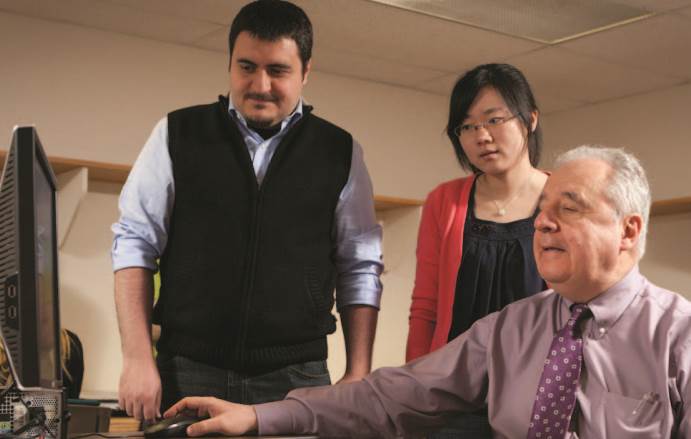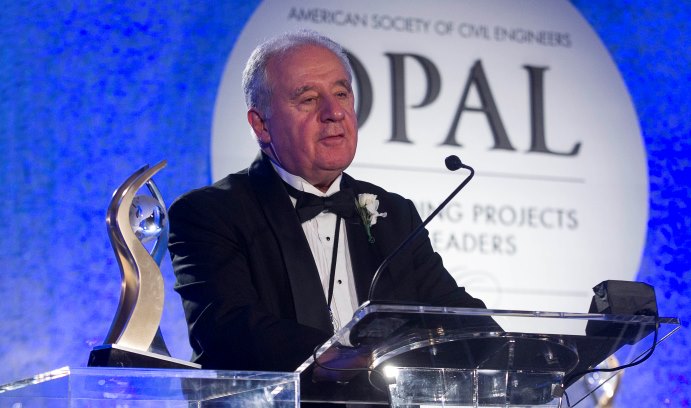A life-cycle pioneer

Frangopol, shown at right with former advisees Duygu Saydam Ph.D. ’13 and Benjin Zhu Ph.D. ’15, has played a leading role in building the professional societies and networks that promote collaboration among life-cycle engineering researchers.
In October 1997, the Journal of Structural Engineering published a paper that gave the field a new way to define success in the design and assessment of infrastructure systems—a paper that, two decades later, has formed the very basis of a global refocusing on building for long-term risk, resilience and sustainability.
Written by Dan Frangopol with two former Ph.D. advisees, the paper, “Life-Cycle Cost Design of Deteriorating Structures,” offered a modest but revolutionary concept: the cost and performance of a structure or a network of infrastructure systems over its entire lifetime are far more crucial to quantify than the initial cost and “day one” performance levels.
Frangopol emphasizes this concept in a simple question: “How do we encourage policy makers and engineers to take the long view rather than focus on the upfront sticker price?”
Frangopol, now the first Fazlur R. Khan Endowed Chair of Structural Engineering and Architecture at Lehigh, is widely recognized as the creator of the field of life-cycle civil engineering. He continues to research, educate students and mentor colleagues. He and his research team perform complex, computationally intense analyses to determine the value and risk of infrastructure investments over the long term.
“The philosophy behind life-cycle engineering is relatively easy to understand,” he says. “Infrastructure systems are societal investments. As such, they must be optimized over their entire life spans while adequately serving society’s needs along the way. To do this, engineers must balance many requirements—safety, serviceability, economy, resiliency, and sustainability—despite imperfect information and knowledge.”
Using probabilistic modeling and analysis, as well as advanced computer simulation, Frangopol leads a generation of engineers in developing the tools and techniques necessary to assess the effects of uncertainties and find optimum solutions that can save money, time and even lives.
“In many ways,” he says, “life-cycle engineering is where the rubber meets the road in terms of risk, resilience and sustainability.”
The American Society of Civil Engineers (ASCE) has asked Frangopol to help lead its efforts to achieve a “Grand Challenge” of reducing the life-cycle cost of infrastructure by 50 percent by 2025. ASCE recently bestowed upon him its prestigious OPAL Award for Lifetime Achievement in civil engineering education. According to ASCE, his contributions “have defined much of the practice around design specifications, management methods, and optimization approaches,” and his research “has not only saved time and money, but very likely also saved lives.”
The structural network
Among Frangopol’s contributions, however, is a different type of infrastructure—intellectual networks that link the brightest structural engineering minds from all over the world and help guide the development of more safe, resilient and sustainable infrastructure systems.
Frangopol has played a leading role in building an interconnected set of professional networks that drive collaboration around some of his field’s most vexing issues. These networks, formalized through international associations that regularly meet and publish cutting-edge research, support the sharing of crucial information across the global structural engineering research community.
In 1999 Frangopol helped create the Inter-national Association for Bridge Maintenance and Safety (IABMAS) and became its founding president. IABMAS encompasses all aspects of bridge maintenance, safety and management. Its more than 1,600 members from 55 countries meet regularly, with international conferences occurring every two years. Frangopol was also instrumental in the creation of the International Association for Life-Cycle Civil Engineering (IALCCE), with about 500 members from 50 countries, and the ASCE’s Technical Council on Life-Cycle Performance, Safety, Reliability and Risk of Structural Systems.
“Over time, new concepts in our field introduce even more complex sets of variables into research around structural design and decision making,” Frangopol says. “At each step, it is critical to support these conceptual shifts with professional networks that integrate expertise and form the basis of broader understanding and application.
“Ultimately, life-cycle engineering is about more than us,” he says. “We’re trying to optimize our world for future generations.”
Posted on:


